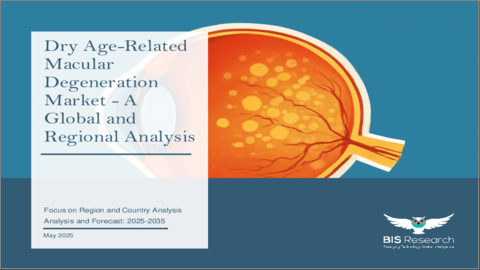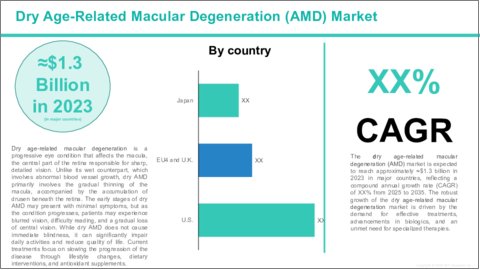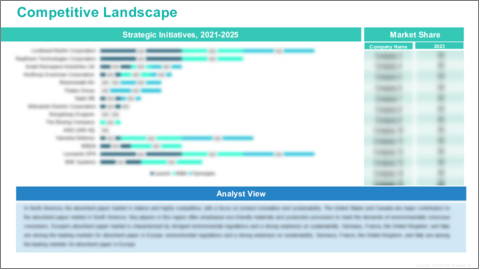|
|
市場調査レポート
商品コード
1724172
乾性加齢黄斑変性の世界市場:地域・国別の分析・予測 (2025~2035年)Dry Age-Related Macular Degeneration Market - A Global and Regional Analysis: Focus on Region and Country Analysis - Analysis and Forecast, 2025-2035 |
||||||
カスタマイズ可能
|
|||||||
| 乾性加齢黄斑変性の世界市場:地域・国別の分析・予測 (2025~2035年) |
|
出版日: 2025年05月14日
発行: BIS Research
ページ情報: 英文 100 Pages
納期: 1~5営業日
|
全表示
- 概要
- 図表
- 目次
乾性加齢黄斑変性は、網膜の中心部である黄斑に影響を与える進行性の目の疾患であり、鮮明な中心視力を担当する部分にダメージを与えます。
この疾患により、読書、運転、顔の識別といった日常生活に欠かせない中央視野の視力が徐々に失われていきます。
乾性加齢黄斑変性の市場は、いくつかの主要な要因によって大きな成長を見せています。主な原動力のひとつは、世界的な高齢化です。加齢は乾性加齢黄斑変性を発症する最も重要なリスク要因であり、高齢者の増加に伴い、効果的な治療法や診断ツールへの需要も高まっています。さらに、光干渉断層計 (OCT) や眼底写真といった網膜画像診断技術の進歩により、病気の早期発見や進行状況のより正確な把握が可能となり、市場の拡大に寄与しています。
また、精密医療や遺伝子検査への関心の高まりにより、患者一人ひとりに合わせた治療が可能となり、臨床成果の向上が期待されています。加えて、目の健康に対する意識の向上や、生活習慣の改善、定期的な眼科検診の普及など、予防的取り組みの拡大も需要を押し上げています。さらに、新興国における医療インフラの改善や、眼科医への専門的な訓練の普及により、革新的な治療法の導入も進んでおり、これら複数の要因が相まって、乾性加齢黄斑変性市場の成長を今後も力強く後押しすると見込まれています。
当レポートでは、世界の乾性加齢黄斑変性の市場を調査し、主要動向、市場影響因子の分析、法規制環境、技術・特許の動向、ケーススタディ、市場規模の推移・予測、各種区分・地域/主要国別の詳細分析、競合情勢、主要企業のプロファイルなどをまとめています。
目次
エグゼクティブサマリー
第1章 世界の乾性加齢黄斑変性市場:業界の展望
- 市場動向
- 規制の枠組み
- 世界の乾性加齢黄斑変性の疫学
- 臨床試験の分析
- 市場力学
- 影響分析
- 市場促進要因
- 市場の課題
- 市場機会
第2章 世界の乾性加齢黄斑変性市場:地域別
- 北米
- 欧州
- アジア太平洋
- 主な調査結果
- 市場力学
- 市場規模と予測
第3章 世界の乾性加齢黄斑変性市場:競合情勢と企業プロファイル
- 主要な展開と戦略
- 企業プロファイル
- AstraZeneca
- Astellas Pharma
- Novartis AG.
- Apellis Pharmaceuticals
- Alkeus Pharmaceuticals.
- Belite Bio.
- Aviceda Therapeutics
- Cognition Therapeutics
- Annexon Biosciences
- Lineage Cell Therapeutics
第4章 調査手法
List of Figures
- Figure: Global Dry Age-Related Macular Degeneration Market, Market Overview
- Figure: Epidemiology of Dry Age-Related Macular Degeneration
- Figure: Global Dry Age-Related Macular Degeneration Market (by Region), $Million, 2023 and 2035
- Figure: Global Dry Age-Related Macular Degeneration Market Coverage
- Figure: Global Dry Age-Related Macular Degeneration Market Key Trends, Impact Analysis, 2023-2035
- Figure: Global Dry Age-Related Macular Degeneration Market, Competitive Landscape, January 2022-April 2025
List of Tables
- Table: Global Dry Age-Related Macular Degeneration Market, Clinical Trial Analysis,
- Table: Global Dry Age-Related Macular Degeneration Market Dynamics, Impact Analysis
- Table: Global Dry Age-Related Macular Degeneration Market (by Region), $Million, 2023-2035
Global Dry Age-Related Macular Degeneration Market, Analysis and Forecast: 2025-2035
Dry age-related macular degeneration is a progressive eye condition that affects the macula, the central part of the retina responsible for sharp, central vision. This condition leads to gradual loss of vision, particularly in the central field of view, which is crucial for activities such as reading, driving, and recognizing faces.
The dry age-related macular degeneration market is witnessing substantial growth, driven by a range of key factors. One of the primary drivers is the aging global population, as age is the most significant risk factor for developing dry age-related macular degeneration. With an increasing number of elderly individuals, the demand for effective treatments and diagnostic tools is on the rise. Additionally, advancements in retinal imaging technologies, such as optical coherence tomography (OCT) and fundus photography, are enabling earlier detection and more precise monitoring of disease progression, driving market growth.
Furthermore, the growing focus on precision medicine and genetic testing is enhancing the ability to tailor treatments to individual patients, thus improving clinical outcomes. The increasing awareness of eye health and the rising adoption of preventive measures, such as lifestyle changes and regular eye screenings, are also stimulating demand. Moreover, the improvement in healthcare infrastructure in emerging markets and the availability of specialized training for ophthalmologists are fuelling the adoption of innovative AMD treatment options. The combination of these drivers is poised to continue supporting the growth of the dry AMD market.
Despite the positive growth trajectory, several challenges continue to impact the global dry age-related macular degeneration market. One of the primary challenges is the high cost of treatment and diagnostic technologies can be a significant barrier. Innovative treatments, especially in the realm of gene therapy, stem cell therapy, and advanced imaging technologies, come with high development and implementation costs. This can limit access to effective therapies in low- and middle-income regions, where healthcare infrastructure may be less developed and resources are limited.
Moreover, lack of effective treatments for the advanced stages of dry AMD. While there are interventions to manage early stages, such as nutritional supplements and lifestyle modifications, there is no cure or approved treatment that can significantly reverse the damage once it progresses to advanced dry AMD or geographic atrophy. This limitation has restricted the market potential for advanced therapies and treatment options.
As the dry age-related macular degeneration market continues to evolve, several emerging trends are expected to significantly influence its future trajectory. The increasing development of innovative treatments, such as gene therapies, retinal implants, and biologic agents targeting disease progression, is poised to provide new hope for patients. Furthermore, advancements in diagnostic technologies, including high-resolution imaging and artificial intelligence-driven tools for early detection, will allow for more precise monitoring and intervention. With the aging global population, particularly in regions with a higher prevalence of AMD, the demand for cost-effective, easy-to-administer, and efficient treatment options will continue to rise. Additionally, increased focus on the role of lifestyle modifications, such as diet and supplements, will shape prevention strategies, offering a holistic approach to managing age-related macular degeneration.
In conclusion, the global dry age-related macular degeneration market is expected to experience steady growth, driven by advancements in therapeutic interventions, heightened awareness, and a focus on early detection. As research and development in this space continue to progress, key stakeholders, including pharmaceutical companies, healthcare providers, and researchers, will play a critical role in improving treatment outcomes and patient quality of life. The market's expansion, coupled with continued innovation, will empower patients with better management tools, reducing the long-term burden of the condition and preserving vision for millions around the world.
Table of Contents
Executive Summary
Scope and Definition
Market/Product Definition
Inclusion and Exclusion
Key Questions Answered
Analysis and Forecast Note
1. Global Dry Age-Related Macular Degeneration Markets: Industry Outlook
- 1.1 Introduction
- 1.2 Market Trends
- 1.3 Regulatory Framework
- 1.4 Epidemiology of Dry AMD
- 1.5 Clinical Trial Analysis
- 1.6 Market Dynamics
- 1.6.1 Impact Analysis
- 1.6.2 Market Drivers
- 1.6.3 Market Challenges
- 1.6.4 Market Opportunities
2. Global Dry Age-Related Macular Degeneration Market, by Region, $Million, 2023-2035
- 2.1 North America
- 2.1.1 Key Findings
- 2.1.2 Market Dynamics
- 2.1.3 Market Sizing and Forecast
- 2.1.3.1 North America Dry Age-Related Macular Degeneration Market, by Country
- 2.1.3.1.1 U.S.
- 2.1.3.1 North America Dry Age-Related Macular Degeneration Market, by Country
- 2.2 Europe
- 2.2.1 Key Findings
- 2.2.2 Market Dynamics
- 2.2.3 Market Sizing and Forecast
- 2.2.3.1 Europe Dry Age-Related Macular Degeneration Market, by Country
- 2.2.3.1.1 Germany
- 2.2.3.1.2 U.K.
- 2.2.3.1.3 France
- 2.2.3.1.4 Italy
- 2.2.3.1.5 Spain
- 2.2.3.1 Europe Dry Age-Related Macular Degeneration Market, by Country
- 2.3 Asia Pacific
- 2.3.1 Key Findings
- 2.3.2 Market Dynamics
- 2.3.3 Market Sizing and Forecast
- 2.3.3.1 Asia Pacific Dry Age-Related Macular Degeneration Market, by Country
- 2.3.3.1.1 Japan
- 2.3.3.1 Asia Pacific Dry Age-Related Macular Degeneration Market, by Country
3. Global Dry Age-Related Macular Degeneration Market: Competitive Landscape and Company Profiles
- 3.1 Key Development and Strategies
- 3.1.1 Mergers and Acquisitions
- 3.1.2 Synergistic Activities
- 3.1.3 Business Expansions and Funding
- 3.1.4 Product Launches and Approvals
- 3.1.5 Other Activities
- 3.2 Company Profiles
- 3.2.1 AstraZeneca
- 3.2.1.1 Overview
- 3.2.1.2 Top Products / Product Portfolio
- 3.2.1.3 Target Customers/End-Users
- 3.2.1.4 Key Personnel
- 3.2.1.5 Analyst View
- 3.2.2 Astellas Pharma
- 3.2.2.1 Overview
- 3.2.2.2 Top Products / Product Portfolio
- 3.2.2.3 Target Customers/End-Users
- 3.2.2.4 Key Personnel
- 3.2.2.5 Analyst View
- 3.2.3 Novartis AG.
- 3.2.3.1 Overview
- 3.2.3.2 Top Products / Product Portfolio
- 3.2.3.3 Target Customers/End-Users
- 3.2.3.4 Key Personnel
- 3.2.3.5 Analyst View
- 3.2.4 Apellis Pharmaceuticals
- 3.2.4.1 Overview
- 3.2.4.2 Top Products / Product Portfolio
- 3.2.4.3 Target Customers/End-Users
- 3.2.4.4 Key Personnel
- 3.2.4.5 Analyst View
- 3.2.5 Alkeus Pharmaceuticals.
- 3.2.5.1 Overview
- 3.2.5.2 Top Products / Product Portfolio
- 3.2.5.3 Target Customers/End-Users
- 3.2.5.4 Key Personnel
- 3.2.5.5 Analyst View
- 3.2.6 Belite Bio.
- 3.2.6.1 Overview
- 3.2.6.2 Top Products / Product Portfolio
- 3.2.6.3 Target Customers/End-Users
- 3.2.6.4 Key Personnel
- 3.2.6.5 Analyst View
- 3.2.7 Aviceda Therapeutics
- 3.2.7.1 Overview
- 3.2.7.2 Top Products / Product Portfolio
- 3.2.7.3 Target Customers/End-Users
- 3.2.7.4 Key Personnel
- 3.2.7.5 Analyst View
- 3.2.8 Cognition Therapeutics
- 3.2.8.1 Overview
- 3.2.8.2 Top Products / Product Portfolio
- 3.2.8.3 Target Customers/End-Users
- 3.2.8.4 Key Personnel
- 3.2.8.5 Analyst View
- 3.2.9 Annexon Biosciences
- 3.2.9.1 Overview
- 3.2.9.2 Top Products / Product Portfolio
- 3.2.9.3 Target Customers/End-Users
- 3.2.9.4 Key Personnel
- 3.2.9.5 Analyst View
- 3.2.10 Lineage Cell Therapeutics
- 3.2.10.1 Overview
- 3.2.10.2 Top Products / Product Portfolio
- 3.2.10.3 Target Customers/End-Users
- 3.2.10.4 Key Personnel
- 3.2.10.5 Analyst View
- 3.2.1 AstraZeneca





